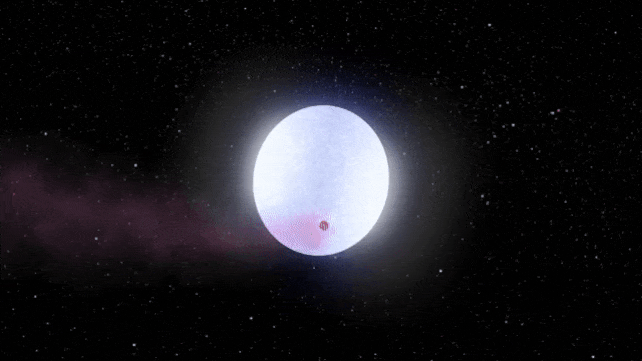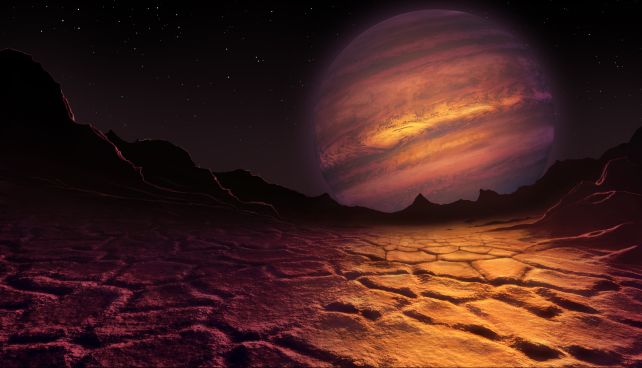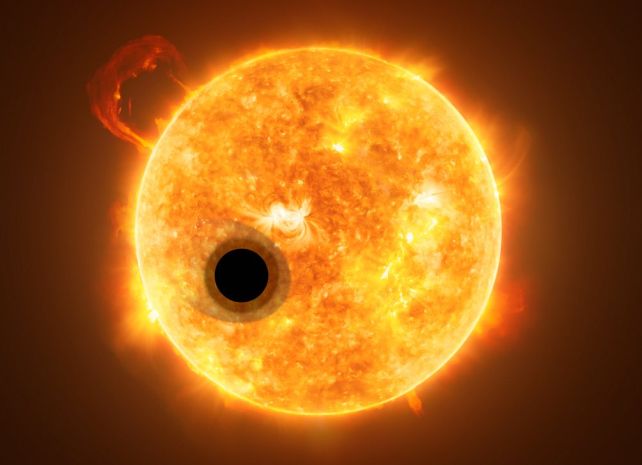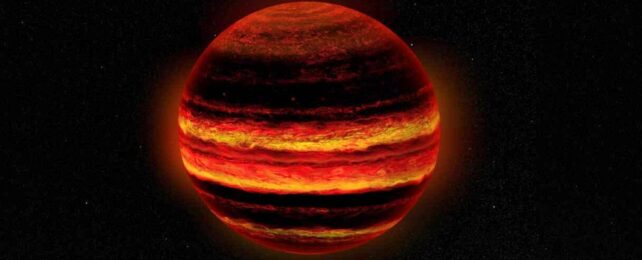An object orbiting a star 1,400 light-years away is seriously confronting our notions of what's possible in the Universe.
It's a brown dwarf, the curious category of objects that straddle the gap between planets and stars, but it's on such a close orbit with its very hot host star that its temperature exceeds a blistering 8,000 Kelvin (7,727 degrees Celsius, or 13,940 Fahrenheit) – hot enough to snap apart the molecules in its atmosphere into their composite atoms.
That's far hotter than the surface temperature of the Sun, where temperatures sit at a comparatively balmy 5,778 Kelvin. In fact, this brown dwarf is a temperature record-breaker – the hottest object of its kind we've ever found.
Even though brown dwarfs tend to be hotter than planets, they burn cooler than the coolest red dwarf stars – they absolutely can't reach Sun-like temperatures on their own internal fusion engines.
An international team led by astrophysicist Na'ama Hallakoun of the Weizmann Institute of Science in Israel has named the object WD0032-317B. Their discovery has been detailed in a paper accepted into Nature Astronomy, and currently available on preprint server arXiv.

The discovery, the team says, can help us understand what happens to Jupiter-like gas giants orbiting extremely hot, massive stars, the observation of which can be challenging due to the properties of the stars, such as their activity and rotation rate.
Planets orbiting close to their stars are irradiated with vast amounts of ultraviolet light. This can cause their atmospheres to evaporate, and the molecules therein to be torn apart, a process known as thermal dissociation.
We don't know a lot about this extreme environment, though. At such close proximity to a very bright star, signals from an orbiting exoplanet can be difficult to tease out from stellar activity.
We know of one exoplanet hot enough for thermal dissociation. That's KELT-9b, orbiting a blue supergiant star, which heats the exoplanet's day side to temperatures in excess of 4,600 Kelvin (4,327 degrees Celsius, or 7,820 degrees Fahrenheit).
That's hotter than most stars – red dwarfs, the most common stars in the galaxy, have a maximum surface temperature of about 4,000 Kelvin.
One way to study these extreme regimes, however, could be brown dwarfs in binary systems with white dwarf stars. White dwarfs are much, much smaller than blue supergiants like KELT-9, which in turn makes them dimmer, and the signal from any superheated companion objects easier to tease out.
A brown dwarf isn't quite a planet, but nor is it quite a star, either. At about 13 times the mass of Jupiter, a planet-like object can have enough pressure and heat in its core to ignite deuterium fusion.
That's a 'heavy' isotope of hydrogen; the temperature and pressure required for its fusion are much lower than the temperature and pressure required for the fusion of regular hydrogen that burns in the cores of stars.![]()

Brown dwarfs can reach about 80 Jupiter masses in size, and temperatures of around 2,500 Kelvin. They're cooler and dimmer than red dwarfs, but do glow in infrared wavelengths.
White dwarfs, on the other hand, are the final stage of life for stars like the Sun. When the star runs out of hydrogen in its core, it ejects its outer layers, and the core, no longer supported by the outward pressure of fusion, collapses down into an ultra-dense object around the size of Earth.
White dwarfs shine with residual heat, but the death process is very energetic – they're extremely hot, with temperatures comparable to those of blue supergiants.
This brings us to WD0032-317, a very hot, low-mass white dwarf star. It's around 40 percent of the mass of the Sun, burning at temperatures around 37,000 Kelvin.
In the early 2000s, data obtained using the Ultra-Violet-Visual Echelle Spectrograph (UVES) instrument on the European Southern Observatory's Very Large Telescope suggested that WD0032-317 was moving around, tugged around on the spot by an unseen, orbiting companion. Late observations in the near infrared suggested that that companion was a brown dwarf.
Hallakou and her colleagues used UVES to obtain new observations of the star, and found that the companion is a brown dwarf with a mass of between 75 and 88 Jupiters on a breakneck orbit of just 2.3 hours.
The smoking gun leading to the detection was, well, a smoking star, kind of. When the brown dwarf's day side is facing us, the astronomers could detect the hydrogen it emits as the star evaporates it.

Because the brown dwarf and the star are so close together, the brown dwarf is tidally locked. That means one side – the day side – is perpetually facing the star, while the other remains in permanent night. The team calculated the extreme temperatures involved, and the numbers are eye-watering.
"Depending on the white-dwarf core model used, the companion's heated day-side temperature ranges between ≈7,250 and 9,800 Kelvin – as hot as an A-type star – with a night-side temperature of ≈1,300 − 3,000 Kelvin, or a temperature difference of ≈6,000 K – about four times as large as that of KELT-9b," they write in their paper.
"The night-side temperature range covers T through M dwarfs. The 'equilibrium' black-body temperature of the irradiated companion (neglecting its intrinsic luminosity and albedo, and assuming it is in thermal equilibrium with the external irradiation) is about 5,100 Kelvin, hotter than any known giant planet, and ≈1,000 Kelvin hotter than KELT-9b, resulting in ≈ 5,600 times higher extreme-ultraviolet flux."
No known planet or brown dwarf is hotter, which makes WD0032-317B not only extremely awesome, but an excellent candidate for studying how extremely hot stars can evaporate their lower-mass companions. Studying objects like WD0032-317B, the researchers say, can help us understand rare outlier objects like KELT-9b.
The research has been accepted into Nature Astronomy, and is available on arXiv.
